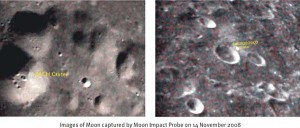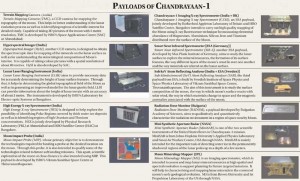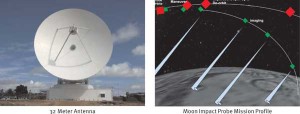The spacecraft is powered by a single solar panel, generating a maximum of 700 W. A 36 Ampere-Hour (Ah) Lithium ion battery supplies power when the solar panel is not illuminated by the sun. To make Chandrayaan-1 spacecraft escape from orbiting the earth and travel towards the moon, its Liquid Apogee Motor (LAM) is used. Liquid propellants needed for LAM as well as thrusters are stored onboard the spacecraft. Chandrayaan-1 spacecraft’s Dual Gimballed Antenna transmits the precious scientific data gathered by its eleven scientific instruments to Earth.
Chandrayaan-1 spacecraft is built at the ISRO Satellite Centre, Bangalore with contributions from ISRO/Department of Space (DOS) establishments like Vikram Sarabhai Space Centre (VSSC), Liquid Propulsion Systems Centre (LPSC) and ISRO Inertial Systems Unit (IISU) of Tiruvananthapuram, Space Applications Centre (SAC) and Physical Research Laboratory (PRL), Ahmedabad and Laboratory for Electro-optic Systems (LEOS), Bangalore.
The Journey: Chandrayaan-1 spacecraft was launched from Satish Dhawan Space Centre (SDSC) SHAR, Sriharikota by India’s Polar Satellite Launch Vehicle (PSLV) into an elliptical Initial Orbit (IO) around the earth. The launch took place from the Second Launch Pad (SLP) at SDSC SHAR. SLP was built to provide redundant facilities for launching PSLV and GSLV from Sriharikota. This launch pad provides quick turnaround time for launches. Besides the present PSLV and GSLV, it can accommodate future launch vehicles like GSLV-Mk III.
SLP works on Integrate, Transfer and Launch (ITL) concept, according to which the new launch pad and the associated facilities are designed and built. First, the entire launch vehicle is assembled and checked-out on a mobile pedestal in a giant Vehicle Assembly Building (VAB) and then moved in vertical position to the launch pad on a rail track. This method reduces the pad occupancy time. At the same time, it enables the vehicle to move back to VAB for protection in the event of any cyclone warning. The important facilities that constitute the SLP include:
- Launch Pad with a 70 metere (231 ft) tall Umbilical Tower and a jet deflector
- 83 metre (274 ft) tall, 40 metre long and 32 metre wide Vehicle Assembly Building
- Twin rail tracks of about a kilometer length connecting VAB and Launch Pad
- Mobile Launch Pedestal over which the vehicle is integrated
- Checkout system
- Propellant and gas storage and transfer facilities for propellants that are liquids at room temperature as well as cryogenic propellants
- Safety systems
- Instrumentation and Control Systems for automatic filling of propellants as well as for gas charging operations
- Associated electrical and air conditioning systems
- A new facility that controls and monitors remotely the liquid propellant filling operations
Also read: Strategic relevance of Gilgit and Baltistan
After reaching space with the help of PSLV-C11 and circling the Earth in its Initial Orbit, Chandrayaan-1 spacecraft was taken into more elliptical orbits by repeatedly firing its Liquid Engine at appropriate moments. While traveling in such an orbit that extends up to 386,000 km from the Earth, Chandrayaan-1 spacecraft encountered the Moon at a safe distance of a few hundred kilometers. At that time, its liquid engine was fired again so that the spacecraft slowed down sufficiently to enable the gravity of the Moon to capture it into an elliptical orbit. This feat of Lunar Orbit insertion, a very crucial manoeuvre, took place on November 8, 2008. Nearly one-third of the missions have been lost while attempting this critical manoeuvre. India achieved this rare feat of lunar orbit insertion in its very first attempt.
 Following this, the height of the spacecraft’s orbit around the Moon was progressively reduced in steps. After a careful and detailed observation of the orbit perturbations in those intermediate orbits, the orbital height of Chandrayaan-1 was finally lowered to its intended 100 km height from the lunar surface.
Following this, the height of the spacecraft’s orbit around the Moon was progressively reduced in steps. After a careful and detailed observation of the orbit perturbations in those intermediate orbits, the orbital height of Chandrayaan-1 was finally lowered to its intended 100 km height from the lunar surface.
Later, the Moon Impact Probe was be ejected from Chandrayaan-1 spacecraft at the earliest opportunity on November 14, 2008 to hit the lunar surface in a chosen area. Following this, cameras and other scientific instruments were turned on and tested. Chandrayaan-1 spacecraft is expected to be in orbit for about two years during which it will explore the lunar surface with its array of instruments that includes cameras, spectrometers and SAR.
The Ground Segment: The ground facilities of Chandrayaan-1 perform the highly important task of receiving the microwaves containing the wealth of information of the spacecraft as well as the valuable scientific information, is transmitted by the spacecraft. It also transmits the radio commands to be sent to the spacecraft during all the phases of its mission. Besides, it processes and archives the scientific data sent by Chandrayaan-1.






